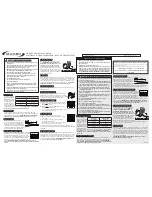
P a g e
|
17
OIPB-I03026-T2200PRO_v3.1
7. Federal Standards
The Occupational Safety and Health Administration (OHSA) standard for exposure to
CO prohibits workers’ exposure to more than 50 parts of gas per million parts of air
(PPM), averaged over an 8-hour work day. There is also a ceiling limit of 200 PPM
measured over a 15-minute period.
21. Propane Safety
Liquid petroleum gas (propane) is flammable and potentially explosive. Always obey proper
handling, lighting, and ventilating procedures provided by the manufacturer. Obey the
safety warnings and procedures below, which are provided to supplement, not replace or
substitute, the manufacturer’s instructions.
NOTE: All new propane tanks must be purged before use.
1. Precautions & Warnings
•
Wear insulated gloves when you handle propane tanks.
•
Do not attempt to adjust the pressure regulator because the manufacturer sets it.
Only a qualified liquid petroleum gas service technician should make adjustments.
•
Inspect the fuel lines and connectors before each job or at the beginning of the day
to detect any possible problems. Never check for propane leaks with an open flame.
•
Never use ammoniated household-type detergents to detect leaks or to clean any
portion of the fuel system or the tank. These substances can cause cracks on brass
fittings and on the fuel line. If the leak cannot be located, take the tank to a certified
liquid petroleum gas service representative.
•
Never store or carry propane containers in a closed space or inside your passenger
vehicle. Propane containers are equipped with safety devices that relieve excessive
pressure by discharging gas to the atmosphere.
•
Never fill a tank more than 80% of capacity. Overfilling can cause uncontrolled gas
flow, which in turn can cause fire and/or an explosion.
2. What to Do If You Smell Gas
•
Immediately extinguish any open flames, pilot lights, and all smoking materials.
•
Turn the engine OFF; do not touch any electrical switches or other devices that may
produce a spark.
•
Shut OFF the fuel flow switch.
•
Open all doors and windows to allow maximum ventilation.
•
Leave the area until the odor clears.
•
Inspect the fuel lines and connectors to determine the source of the leak. Correct the
problem before you use the Terminator
®
again.
22. Maintenance Procedures
1. Change Hydraulic Oil every 18 months with NUTO H 46 or ISO 46 or if fluid is
overheated 200°F or higher.
2. Change hydraulic filter every 50 hours initially.
Discount-Equipment.com
Summary of Contents for Innovatech Terminator T-2200PRO
Page 26: ...P a g e 25 OIPB I03026 T2200PRO_v3 1 D i s c o u n t E q u i p m e n t c o m...
Page 30: ...P a g e 29 OIPB I03026 T2200PRO_v3 1 D i s c o u n t E q u i p m e n t c o m...
Page 34: ...P a g e 33 OIPB I03026 T2200PRO_v3 1 D i s c o u n t E q u i p m e n t c o m...
Page 36: ...P a g e 35 OIPB I03026 T2200PRO_v3 1 D i s c o u n t E q u i p m e n t c o m...
















































